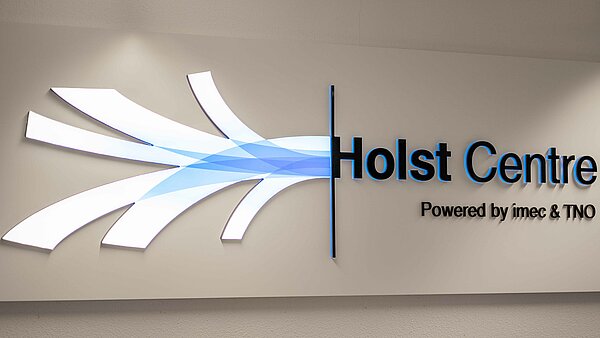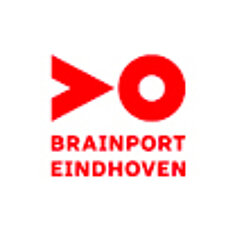'A future where clothing speaks directly to our bodies.' Interview with Caroline Ruijg of Touchwaves.

Can you tell us about Touchwaves?
My name is Caroline Ruijg and I am commercial director at Touchwaves. With this spin-off from TNO, we develop intelligent textiles that communicate with the body via touch waves. My fellow co-founders Pauline van Dongen and Charlotte Kjellander imagined a future where clothing directly addresses and guides our bodies. Together, they investigated how to integrate technological applications into textiles while maintaining flexibility and washability. The project is an initiative of TNO Holst Centre, with employees from twenty-eight countries working together to solve global societal challenges.
All three of us experienced the power of breathing. How it can positively influence your life and but also hinder it. AND how a good breathing technique can relieve anxiety, pain or stress. It was therefore a logical step for us to investigate whether an application could be devised in which interactive textiles could provide support and guidance for breathing.
600,000,000 people worldwide suffer from anxiety disorders.
Local market research shows that 25% of those surveyed are hampered by anxiety to the extent that their daily functioning suffers, while 75% of them seek help.
In 68% of cases, help focuses on teaching the right breathing technique, while 63% of people also seek physical tools to manage anxiety. Scientific research shows that learning proper breathing technique reduces anxiety and stress symptoms and has a positive impact on our health and well-being. Treatments for anxiety disorders often include various breathing exercises, making it possible to improve the balance between body and mind.
Imagine how nice it would be if you could get support from an invisible breathing coach? That's exactly how the MYSA shirt works. It is a soft shirt with patented haptic technology that you wear under your clothes, directly against your body. Thanks to invisible tiny vibration motors with ultra-thin wash-out electronics in strategic places, it subtly supports your breathing. MYSA-shirt shows that clothing and healthcare technology go perfectly well together.

How did the idea come about?
As I mentioned, all three of us have experience with breathwork; Pauline encountered it after a period of prolonged stress and hyperventilation. Charlotte developed meningitis at eighteen from which she has chronic headaches. And I developed driving anxiety during my college days. For a long time, I pretended it wasn't there because I was ashamed of it. Until I got a driving instructor who realized what was going on. He said to me "come on, we're going to do this breathing exercise and you breathe through your fear. Do you know I still use that technique today? Good breathing technique and body awareness has helped all three of us through difficult periods.
The idea of combining this technique with our MYSA shirt came from the realization that it could have social impact.
How wonderful would it be if we could help large groups of people with this technique and support? From PTTS to stuttering, anxiety attacks to pain management support, all benefit from good breathing and the MYSA shirt offers a unique way of supporting this. Pauline's background in Fashion Design and Charlotte's knowledge of Materials Science proved to be a golden combination to turn the idea into a successful prototype. The result is a shirt designed so you can wear it comfortably throughout the day and wash it easily. Through an app, you can specify which support or breathing program you need. The gentle stimulation that moves across your back like a wave subtly reminds you of the frequency of breathing that is appropriate for that moment.
We presented the prototype to 80 experts such as psychotherapists, psychosomatic therapists, breathing coaches, rehabilitation physicians and osteopaths, as well as letting potential end users experience what the MYSA shirt can do. The response was incredibly positive and promising. Due to waiting lists in healthcare, it often takes time before there is room with a therapist. With our development, you can take therapy home with you. You can do it yourself. Moreover, the technology gives additional tools to therapists because the data can also be used in the treatment process.
Where are you now in the development?
We are currently developing a new design that has a substantially higher "Technological Readiness Level" than our current prototype. In Q1 next year, we are going to produce a significant number of shirts so that we can test on a larger scale through pilot programs. We plan to establish several collaborations with, among others, youth care, rehabilitation and pain clinics as well as an institute in stutter therapy, integrating the breathing therapy they have developed themselves into one of our shirts, so that we can investigate whether users can better understand and apply the therapy this way.
Our goal is to gain deeper insight into the effect of MYSA on the person and how MYSA is used; especially after the treatment sessions.
Because the data from the shirt is available throughout the day, we can analyze in detail and accurately what is effective and what is not.
The Dutch Air Force has indicated its intention to conduct further testing. During our initial tests, F-35 pilots wore a prototype of our shirts during flight simulations. This yielded very interesting results, such as increased alertness during flight. We will now investigate this further and also whether our technology contributes to an accelerated recovery process.
Touchwaves is also part of imec's istart acceleration program, awarded as the best acceleration program in the world. Imec is a leading university microelectronics center from Belgium that operates as a joint venture with TNO at the HighTech Campus in the Holst Centre. With the istart program they guide promising startups, and we are proud to be the first TNO spin-off selected for this program. They guide us to mold our innovation into a strong business model. They also invested in our company and through their network, among others, we did a market survey that interviewed a thousand people aged 25 to 60. It showed that one-fourth of this group suffers from stress or anxiety to such an extent that it affects their daily lives. And that three-quarters of this group actively sought help for their symptoms, but often lack the tools to manage it properly. This insight is valuable to us, as it shows that there is a clear problem and that people want to be helped. Even with a support system.

What do you need to take the next step with the company?
As stated earlier, we are currently preparing for our pilots scheduled to be implemented in 2024. Our goal is to enter the market in 2025. In 2024, we will do several pilots with different target groups to validate our product, market fit. We are investigating which target group is the right one and whether they are willing to pay the price we need. We are also investigating an effective way to reach our potential customers. Therapists and clinics are attractive channels because a relationship of trust already exists. Moreover, therapists see the value of our technology and it gives them additional tools; for example, by monitoring data, they gain more insight into their clients' usage and needs. In doing so, our solution can help reduce waiting lists.
We are now in the process of securing budget to conduct our pilots and prepare for product launch. Then in 2025 we plan a larger round of investment to expand and grow our business. This funding will allow us to reduce our costs, optimize our resources, make MYSA and Touchwaves visible in the market, grow our team and further develop our channels and infrastructure. We will have the help of the acceleration program and coaches to guide us in that growth.
Where do you want to be in five years?
In five years, we aim to bring about a substantial change in the daily lives of people suffering from anxiety disorders. Our ambition is to work closely with this target group to develop a highly effective product that seamlessly addresses their specific needs. Our goal is to build a community of ten thousand users with whom we have direct contact to evaluate how they experience our shirt and how we can improve our products. In addition, we aim to become a leading B2C brand in the tech market; something that is quite unusual.
I am committed to the mission and values that represent our brand. It is essential for us to offer significant value to our users while providing great customer support with a high service level. It is also important for us to work with optimized research and development so that we can further improve and scale our technology in a very cost-effective way.
With Touchwaves, we aim to innovate not only in the field of breathwork, but also to develop other applications and technologies for various audiences.
We see promising opportunities for this technology, especially in the medical sector. People's interest in paying for a pain-relieving application with haptic feedback confirms the potential of our plans. Our goal in five years is to have built a solid position in the market on these foundations, making a tangible impact on the daily functioning of people struggling with anxiety disorders and other related conditions that limit their lives.

How can the Brainport Ecosystem help you achieve the goals?
We work with small, local companies like 2M in Valkenswaard or TracXon in Eindhoven. Because there are many contact moments, proximity, accessibility, and flexibility are very important. Eindhoven's ecosystem is world famous. Even in Singapore the city is known as a tech hub, how nice is that? What I like about this region is the will to work together; everyone is willing to help you, give valuable tips or provide warm introductions.
It would be nice if in the near future we find some regional companies that want to participate in our pilots such as regional healthcare pilot facilities, so that we can soon test our MYSA shirts with institutions from the region. Access to funding is also important to us. So we practiced and prepared pitches with BOM and BSF and through a funding table. At such a table, for example, there are also banks who provided us with interesting feedback that allowed us to improve our pitch. That was very valuable.
Not to mention, access to talent. For example, we collaborated with the Innovation Hub powered by Fontys, where a group of students functioned as a consultancy group, and we have TU/e students involved in MYSA. These kinds of initiatives are helpful for us and the students. We are female founded. We think that's important, but it's not something we emphasize.
We found each other because we have complementary skills, not so much because we are women.
It is encouraging to see, though, that there is increased focus on female entrepreneurship in the tech world. I would love to connect with other women entrepreneurs from this region, active in deep tech so we can learn from each other, encourage and support. Should any women read this and get excited about this please contact me!
What question do you have for other pioneers within Medtech?
What innovative strategies are crucial in scaling up from a startup to a scale-up? I am curious to hear about "lessons learned" and smart, innovative steps for a successful transition during this exciting phase.
